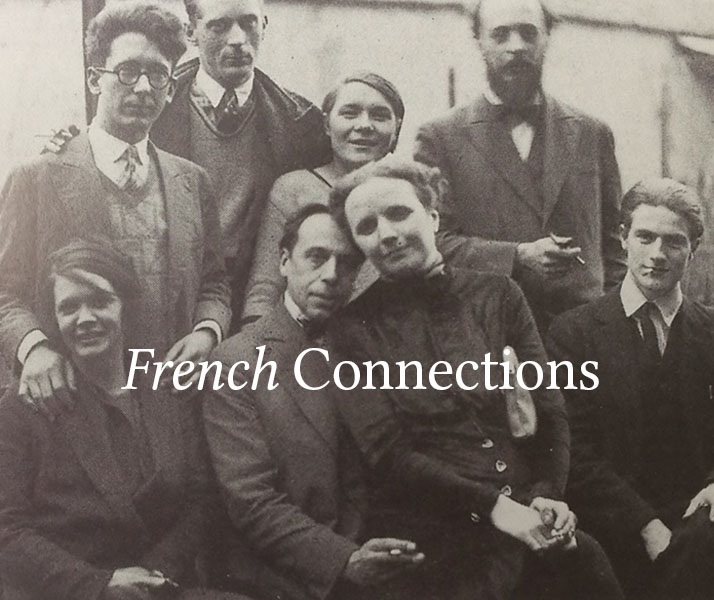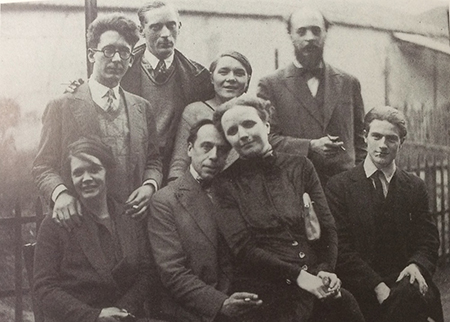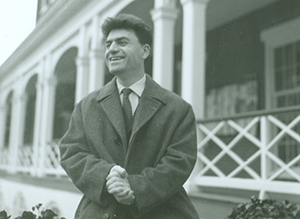
French Connections
This story, told during a reunion event by Jenine Culligan, Marilyn Moriarty, and Beth Harris, is the stuff of adventure movies. Among the cast of characters are two war heroes: One was blinded at a young age and still fought in the French Resistance and survived the horrors of Buchenwald; the other was a significant 20th-century artist. And they are both connected to Hollins.
Jean Hélion: Artist
By Jenine Culligan, director of the Eleanor D. Wilson Museum
In the 1930s, a young Sweet Briar College graduate from Richmond, Virginia, named Jean Blair traveled to Paris and fell in love with a young French modernist painter named Jean Hélion. Hélion was an influential artist and writer who founded the groups Art Concret and Abstraction-Création. After Hélion and Blair married in 1932, Hélion traveled to the United States for the first time. He fell in love with New York, describing it as the only city with a true modern spirit.
Two events occurred in 1939 that would have a large impact on Hollins. Louis Blair was born, the son of Jean Hélion and Jean Blair, who before the war split their time between Rockbridge Baths, Virginia, and France. That same year Hollins art professor John Ballator invited Hélion to exhibit his paintings on the Hollins campus.
In 1940, four months before the Nazis began their occupation of France, Hélion left to join the French army. Six months later he was taken prisoner and was interned in a camp near the Polish border. After a dramatic escape, the artist made his way to Paris. In October 1942, he arrived in the United States where, to aid the Free French, he lectured widely on his war experiences and wrote a bestseller, They Shall Not Have Me.
Hélion died in 1987. His paintings are best known in France, but in the past 20 years his work has been re-examined and shown in major retrospective exhibits and accompanying catalogs. Louis Blair has given hundreds of his father’s works to the Wilson Museum (see sidebar), including the sketch shown on these pages, unveiled at the reunion event, of Jacques Lusseyran.
 The Art Concret Group, founded by Jean Hélion (far left). Standing on right: Otto Carlsund. Couple in center unidentified. Seated from left to right: Jean Blair, Theo and Nelly Van Doesburg, Marcel Vantz. The photograph came from a catalog for a 2004-05 exhibition on the work of Jean Hélion at the Centre Georges Pompidou.
The Art Concret Group, founded by Jean Hélion (far left). Standing on right: Otto Carlsund. Couple in center unidentified. Seated from left to right: Jean Blair, Theo and Nelly Van Doesburg, Marcel Vantz. The photograph came from a catalog for a 2004-05 exhibition on the work of Jean Hélion at the Centre Georges Pompidou.
Photo credit:The Fonds Jean Hélion à l’Institut Memoires de l’Edition Contemporaine, Paris, France
Jacques Lusseyran: Activist, Teacher, and Writer
By Marilyn Moriarty, professor of English
Jacques Lusseyran lost his eyesight at the age of seven or eight. He attributed his many successes in life to his memory, which he said made room for everything: for example, 1,050 Paris telephone numbers (for use by the French Resistance), 15 pages from letters of Cicero in Latin, the metaphysical system of monads according to Gottfried Leibniz, and 19th-century Turkish history.
Before entering the University of Paris in the fall of 1942, he had been part of a group of France’s brightest students, the Upper First. Students were to learn all of Latin, Greek, and French literature, philosophy, the history of the ancient world, and world history from 1715 to the modern day.
When Lusseyran’s beloved tutor, a Jew, was taken away by the Gestapo, Lusseyran fell ill. After his fever broke, Lusseyran resolved to meet with 10 of his friends to discuss the German occupation of France. They formed a group called the Volunteers of Liberty, which built an information network and helped downed Allied airmen out of the country. In 1943, the Volunteers of Liberty joined with another group, the Défense de la France (DF).
In July 1943, Lusseyran was arrested after the DF was infiltrated and betrayed by a German spy. He was eventually sent to the concentration camp at Buchenwald and survived illness and hardships until the camp was liberated in 1945.
Lusseyran was 34 when, in August 1958, he arrived in New York aboard the American ship The Independence. He was bound for the Hollins campus to teach French literature. Lusseyran always said he was born three times: first, when he came into the eart; second, when he lost his sight; and third, when he stepped on board the ship to come to America.
How Lusseyran and Hélion met:
The lives of the two men crossed in France in the 1950s when Hélion attended a meeting at which Lusseyran was a guest speaker. They connected over their wartime experiences, and Lusseyran became a frequent visitor to Hélion’s studio, where Hélion sketched and painted multiple portraits of his friend.
Lusseyran at Hollins
By Beth Harris, special collections librarian and archivist

Jacques Lusseyran taught French literature at Hollins from 1958 to 1961.
Lusseyran was a visiting professor of French literature from fall 1958 through spring 1961. Susan London Riser ’60 remembered, “When he came to Hollins, I think most Hollins Abroaders flocked to his classes. He taught in Bradley and paced the stage, usually with a cigarette in his mouth. When he got close to the edge we would hold our breath. He then explained his ability to sense objects and obstacles.”
Julia Gray Manning ’59, who took two of Lusseyran’s classes, recalled “that he could identify each of us by our footsteps, by name, as we entered the class. It seemed he could do it even if we wore different shoes. He missed occasionally but not often.”
The late Fenton Goodwin Friend ’59 wrote that “he never spoke of his experience in the war—I did not know anything about it until I read his book [And There Was Light] after I graduated.”
Years after Lusseyran’s death, his courage in reinventing his life as a blind person was one of the inspirations for Anthony Doerr’s bestselling novel All the Light We Cannot See.
![]()
The Blair Family’s Gift to Hollins
When Professor of Art Emeritus Bill White retired in 2010, his good friend Louis Blair, the son of Jean Hélion and Jean Blair, donated four of his father’s works to the Wilson Museum in White’s honor. In early 2016, thanks to their friendship and White’s guidance, Blair gave the museum a treasure trove of more than 400 sketches, drawings, prints, and small paintings by his father, along with funds to enable the museum to purchase archival flat files and storage materials to safeguard the collection in perpetuity. These sketches explore the disparate details that went into Hélion’s finished works. Depicted are everyday street scenes, including mannequins, shop windows, flea markets, people with umbrellas and reading newspapers, car accidents, still lifes, and the female figure. In 2017, the Hélion family, through Blair, donated Relevé de la Figure Tombée, 1985, a large-scale brightly colored painting that combines figuration and abstraction. Hollins is now the largest repository of works by Jean Hélion.
—Jenine Culligan

This pastel sketch of Jacques Lusseyran by Jean Hélion was unveiled during the reunion talk. It is one of more than 400 works donated by the Blair family.
